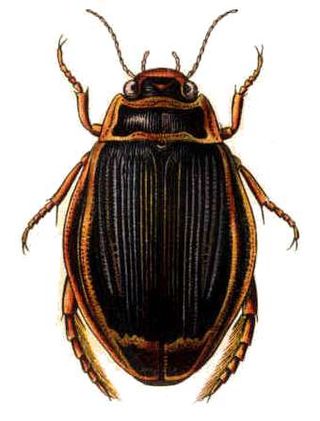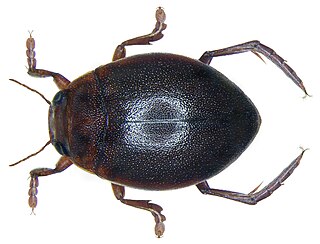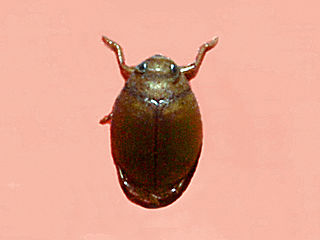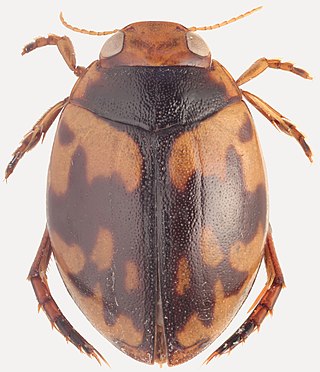
A water beetle is a generalized name for any beetle that is adapted to living in water at any point in its life cycle. Most water beetles can only live in fresh water, with a few marine species that live in the intertidal zone or littoral zone. There are approximately 2000 species of true water beetles native to lands throughout the world.

The Haliplidae are a family of water beetles that swim using an alternating motion of the legs. They are therefore clumsy in water, and prefer to get around by crawling. The family consists of about 200 species in 5 genera, distributed wherever there is freshwater habitat; it is the only extant member of superfamily Haliploidea. They are also known as crawling water beetles or haliplids.

Dytiscus is a Holarctic genus of predaceous diving beetles that usually live in wetlands and ponds. There are 26 species in this genus distributed in Europe, Asia, North Africa and North and Central America. They are predators that can reduce mosquito larvae.

The Dytiscidae – based on the Greek dytikos (δυτικός), "able to dive" – are the predaceous diving beetles, a family of water beetles. They occur in virtually any freshwater habitat around the world, but a few species live among leaf litter. The adults of most are between 1 and 2.5 cm (0.4–1.0 in) long, though much variation is seen between species. The European Dytiscus latissimus and Brazilian Megadytes ducalis are the largest, reaching up to 4.5 cm (1.8 in) and 4.75 cm (1.9 in) respectively. In contrast, the smallest is likely the Australian Limbodessus atypicali of subterranean waters, which only is about 0.9 mm (0.035 in) long. Most are dark brown, blackish, or dark olive in color with golden highlights in some subfamilies. The larvae are commonly known as water tigers due to their voracious appetite. They have short, but sharp mandibles and immediately upon biting, they deliver digestive enzymes into prey to suck their liquefied remains. The family includes more than 4,000 described species in numerous genera.

Dytiscus latissimus is a large species of aquatic beetle in family Dytiscidae. It is native to Europe and considered threatened.

Acilius is a holarctic genus of diving beetles in the family Dytiscidae and typically has a life cycle that is univoltine.

Hyphydrus is a genus of diving beetle native to the Palearctic, the Afro-tropical region, the Near East, North Africa. It contains the following species:
Clypeodytes is a genus of beetles in the family Dytiscidae, containing the following species:

Megadytes glaucus is a species of beetles of the family Dytiscidae.

Copelatus glyphicus is a species of diving beetle. It is part of the genus Copelatus in the subfamily Copelatinae of the family Dytiscidae. It was described by Say in 1823.

Copelatus sociennus is a species of diving beetle. It is part of the subfamily Copelatinae in the family Dytiscidae. It was described by J. Balfour-Browne in 1952. The species can be found on Coloane and in Seac Pai Van. It feeds on Nelumbo nucifera.

Dineutus loriae is a species of beetle within the family of whirligig beetles, or Gyrinidae. The species name loriae honors the Italian explorer Lamberto Loria (1855–1913). This beetle can reach a length of about 20 mm.

Copelatini is a tribe of diving beetles in the family Dytiscidae. It is the sole tribe in the subfamily Copelatinae. The largest genus within the tribe is Copelatus, which has about 470 described species found worldwide, but most diverse in tropical South America, Africa and South-East Asia.

Hyphydrus ovatus is a species of diving beetles in the family Dytiscidae.

Hydroporinae is a subfamily of predaceous diving beetles in the family Dytiscidae. There are at least 2,200 described species in Hydroporinae.

Aciliini is a tribe of predaceous diving beetles in the family Dytiscidae. There are 7 genera and at least 69 described extant species in Aciliini, along with 5 fossil species.

Hyphydrini is a tribe of predaceous diving beetles in the family Dytiscidae. There are about 16 genera and more than 390 described species in Hyphydrini.
Hyphydrus intermixtus, is a species of predaceous diving beetle found in India and Sri Lanka.
Hydrovatus lyratus, is a species of predaceous diving beetle widespread in South Asia, South East Asia and Australian region.
Hydrovatus renardi, is a species of predaceous diving beetle widespread in India, Bangladesh, Bhutan, Myanmar, Nepal, Pakistan, and Sri Lanka.















